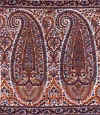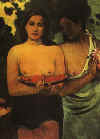|
|
the-south-asian.com FEBRUARY 2002 |
||||
|
FEBRUARY 2002 Contents Lifestyle Ageing - breaking mind barriers! 'My Secret of
Longevity' Literature Performing Arts South
Asians in News 2001 Leadership Know
Your Leaders
Feature People Sports Sunita
Sharma - India's First Books 'Knock
at Every Alien Door' Films Vasundhara
Das - the bride of Fashion & Jewellery
Books
|
|
Special Sections the-south-asian
data bank
|
|||
| print gallery | |||||
|
Page 1 of 5
The South Asian MANGO - The Fruit of Kings & the King of Fruits by Salman Saeed
The Mango fruit tree’s botanical name is "Mangifera Indica" - the Latin botanical name indicates its origin - India .The original root name was the Tamil word "mangay"; in Chinese it is "Mang-two" ; [incidentally in London’s China town Sunday market I learnt that Moo-Li was Chinese for the south Asian mooli/radish; ]. According to Frederick Noronha, "No tree in history (of India) has been given as many names as the mango tree – it has been called Vasantaduta (messenger of Spring), Madhuduta (messenger of fragrance), Kamang ( embodiment of Cupid), Kokilavasa (abode of cuckoos), and Kamavallabha ( the amorous)." The Mango has been around 4000 years and is related surprisingly to the cashew and pistachio nut. It is a unique fruit that sets apart the South Asian regions from the rest of the mango growing regions of the world - where the mango got transplanted from India. The mango was taken to Brazil by the Portuguese and by Indians to the Far East. An entire history and culture revolves around the mango going back thousands of years during Buddha’s times. The story of mangoes is as complex and captivating as the mango tree itself, which produces fruit every season.
Mango Meditation
Mango Mythology Mango blossoms are used in the worship of Saraswati, the goddess of learning. Mangoes are also considered in India to be a symbol of life. In everyday life in India even to this day mango leaves are used to decorate the archways of the house when a wedding occurs or when a new house is constructed. Mango leaves are also used as decoration in celebrating the festivals of Ganesh Chathurthi and Vasant Panchami.
Mango motifs
Mango in Art
Mango trees were painted in detail by the Kangra miniature school in India. There are a couple of well known paintings by the French Impressionist Paul Gauguin who had gone and settled to paint in Tahiti. " The mango quivers with the joy of love "Photo source:-goloka.com-Copyright New Delhi Museum Two women in a mango orchard
|
|||||
| Copyright © 2000 [the-south-asian.com]. Intellectual Property. All rights reserved. | |||||
| Home | |||||






